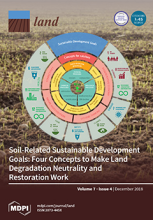Land Library
Welcome to the Land Portal Library. Explore our vast collection of open-access resources (over 74,000) including reports, journal articles, research papers, peer-reviewed publications, legal documents, videos and much more.
/ library resources
Showing items 1 through 9 of 16.Historically, the Nile Delta has played an integral part in Egyptian civilization, as its fertile soils have been cultivated for centuries.
Piñon (Pinus spp.) and juniper (Juniperus spp.) expansion and infilling in sagebrush (Artemisia L.) steppe communities can lead to high-severity fire and annual weed dominance.
The rural proletariat constitute a substantial proportion of the global poor. Leading better lives is central to their political practices. In this paper, I aim to elaborate the political practices that attend to these aspirations, interrogations and contests.
Both fire and conifer encroachment can markedly alter big sagebrush communities and thus habitat quality and quantity for wildlife. We investigated how conifer encroachment and spring prescribed burning affected forage and cover resources for a sagebrush specialist, the pygmy rabbit.
Ranching generally causes a progressive deforestation. Nevertheless in Mediterranean countries trees are still present in many pastoral systems, here referred to as silvopastoral systems (SPs).
Mediterranean agro-forestry systems are undergoing rapid change due to abandonment. This turns formerly cultivated or grazed oak-tree parklands (i.e., savanna-type formations called âdehesasâ) into flammable formations of scattered trees within a matrix of shrubs with open spaces.
The encroachment of woody species in natural grasslands has recently increased, especially in arid and semi-arid environments.
To assess the spatial patterns of forest expansion (encroachment and densification) for mountain pine (Pinus uncinata Ram.) during the last 50 years at a whole mountain range scale by the study of different topographic and socio-economic potential drivers in the current context of global change.
Accurate a priori predictions of the sensitivity of species to vegetation management depend on an understanding of mechanisms underlying species response.


